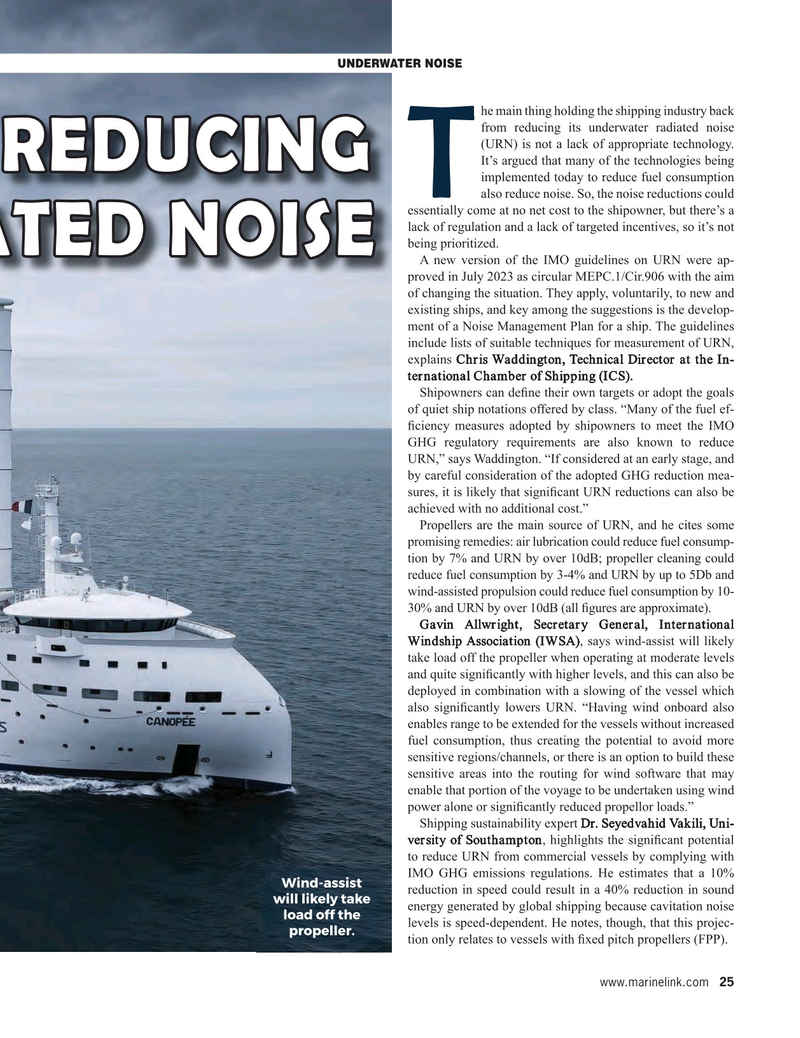
Page 25: of Maritime Reporter Magazine (December 2023)
Great Ships of 2023
Read this page in Pdf, Flash or Html5 edition of December 2023 Maritime Reporter Magazine
UNDERWATER NOISE he main thing holding the shipping industry back from reducing its underwater radiated noise (URN) is not a lack of appropriate technology.
It’s argued that many of the technologies being
REDUCING implemented today to reduce fuel consumption
T also reduce noise. So, the noise reductions could essentially come at no net cost to the shipowner, but there’s a lack of regulation and a lack of targeted incentives, so it’s not being prioritized.
ATED NOISE
A new version of the IMO guidelines on URN were ap- proved in July 2023 as circular MEPC.1/Cir.906 with the aim of changing the situation. They apply, voluntarily, to new and existing ships, and key among the suggestions is the develop- ment of a Noise Management Plan for a ship. The guidelines include lists of suitable techniques for measurement of URN, explains Chris Waddington, Technical Director at the In- ternational Chamber of Shipping (ICS).
Shipowners can de? ne their own targets or adopt the goals of quiet ship notations offered by class. “Many of the fuel ef- ? ciency measures adopted by shipowners to meet the IMO
GHG regulatory requirements are also known to reduce
URN,” says Waddington. “If considered at an early stage, and by careful consideration of the adopted GHG reduction mea- sures, it is likely that signi? cant URN reductions can also be achieved with no additional cost.”
Propellers are the main source of URN, and he cites some promising remedies: air lubrication could reduce fuel consump- tion by 7% and URN by over 10dB; propeller cleaning could reduce fuel consumption by 3-4% and URN by up to 5Db and wind-assisted propulsion could reduce fuel consumption by 10- 30% and URN by over 10dB (all ? gures are approximate).
Gavin Allwright, Secretary General, International
Windship Association (IWSA), says wind-assist will likely take load off the propeller when operating at moderate levels and quite signi? cantly with higher levels, and this can also be deployed in combination with a slowing of the vessel which also signi? cantly lowers URN. “Having wind onboard also enables range to be extended for the vessels without increased fuel consumption, thus creating the potential to avoid more sensitive regions/channels, or there is an option to build these sensitive areas into the routing for wind software that may enable that portion of the voyage to be undertaken using wind power alone or signi? cantly reduced propellor loads.”
Shipping sustainability expert Dr. Seyedvahid Vakili, Uni- versity of Southampton, highlights the signi? cant potential to reduce URN from commercial vessels by complying with
IMO GHG emissions regulations. He estimates that a 10%
Wind-assist reduction in speed could result in a 40% reduction in sound will likely take energy generated by global shipping because cavitation noise load off the levels is speed-dependent. He notes, though, that this projec- propeller. tion only relates to vessels with ? xed pitch propellers (FPP).
www.marinelink.com 25
MR #12 (18-33).indd 25 12/5/2023 12:29:24 PM

 24
24

 26
26
